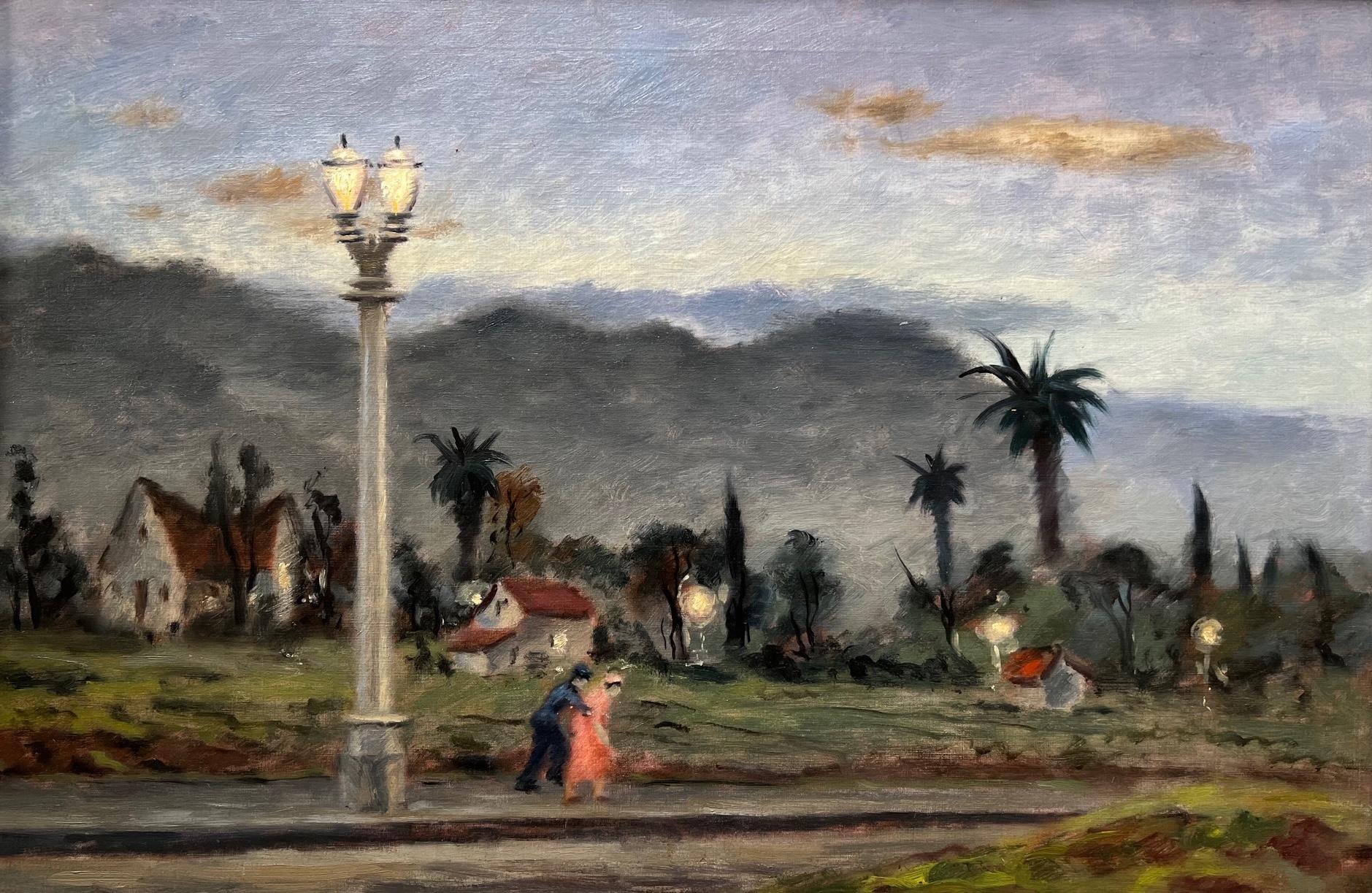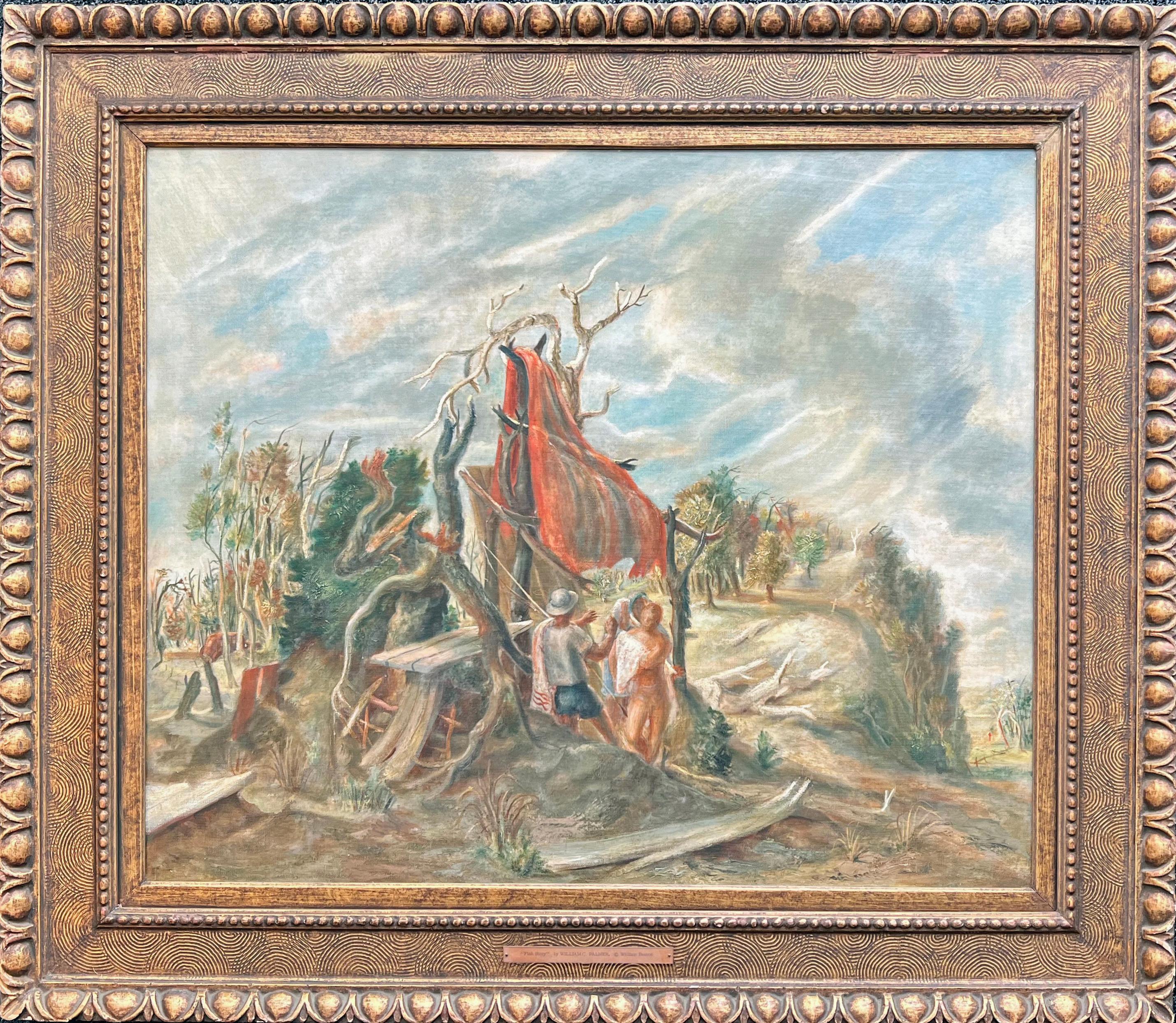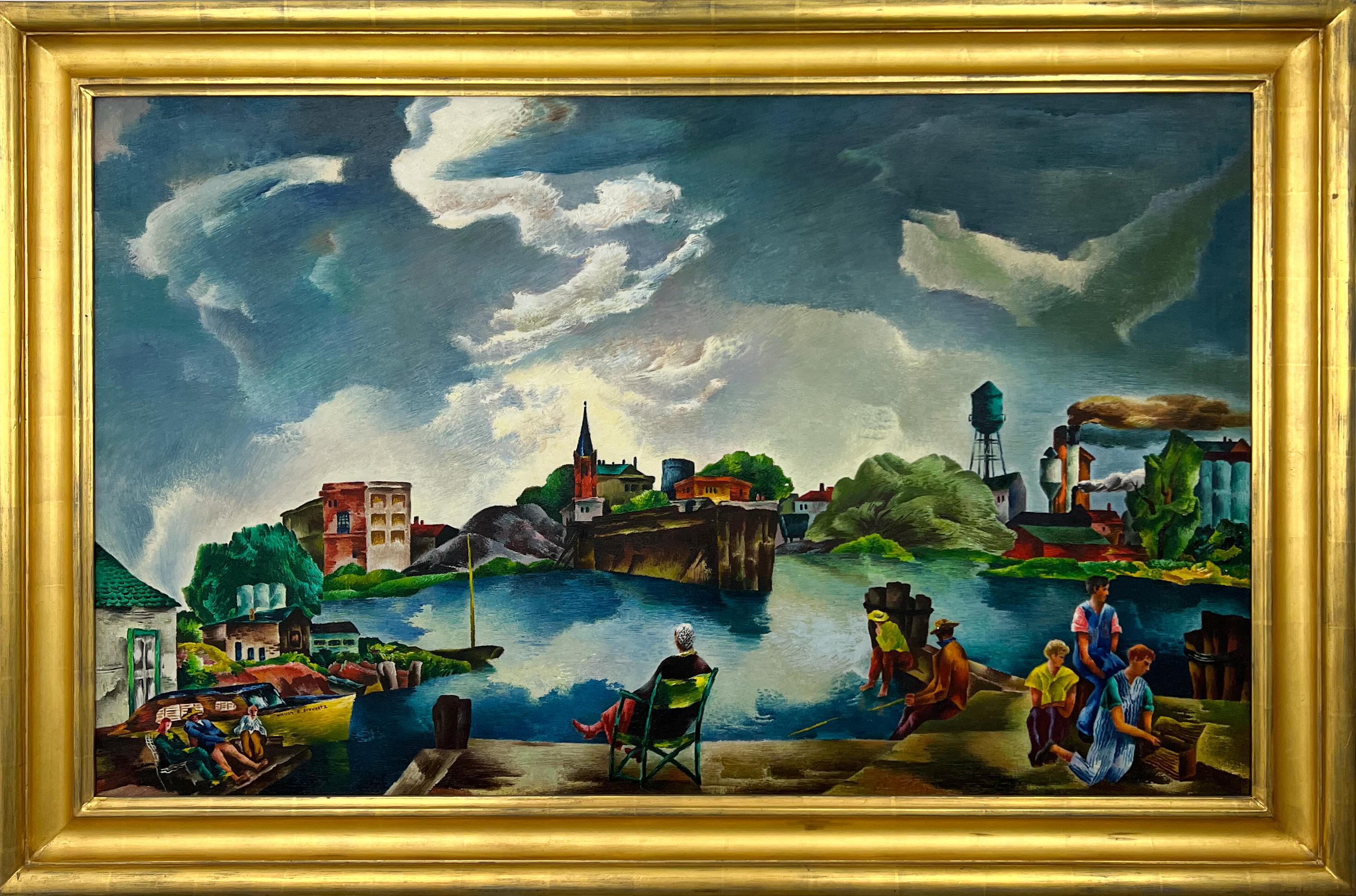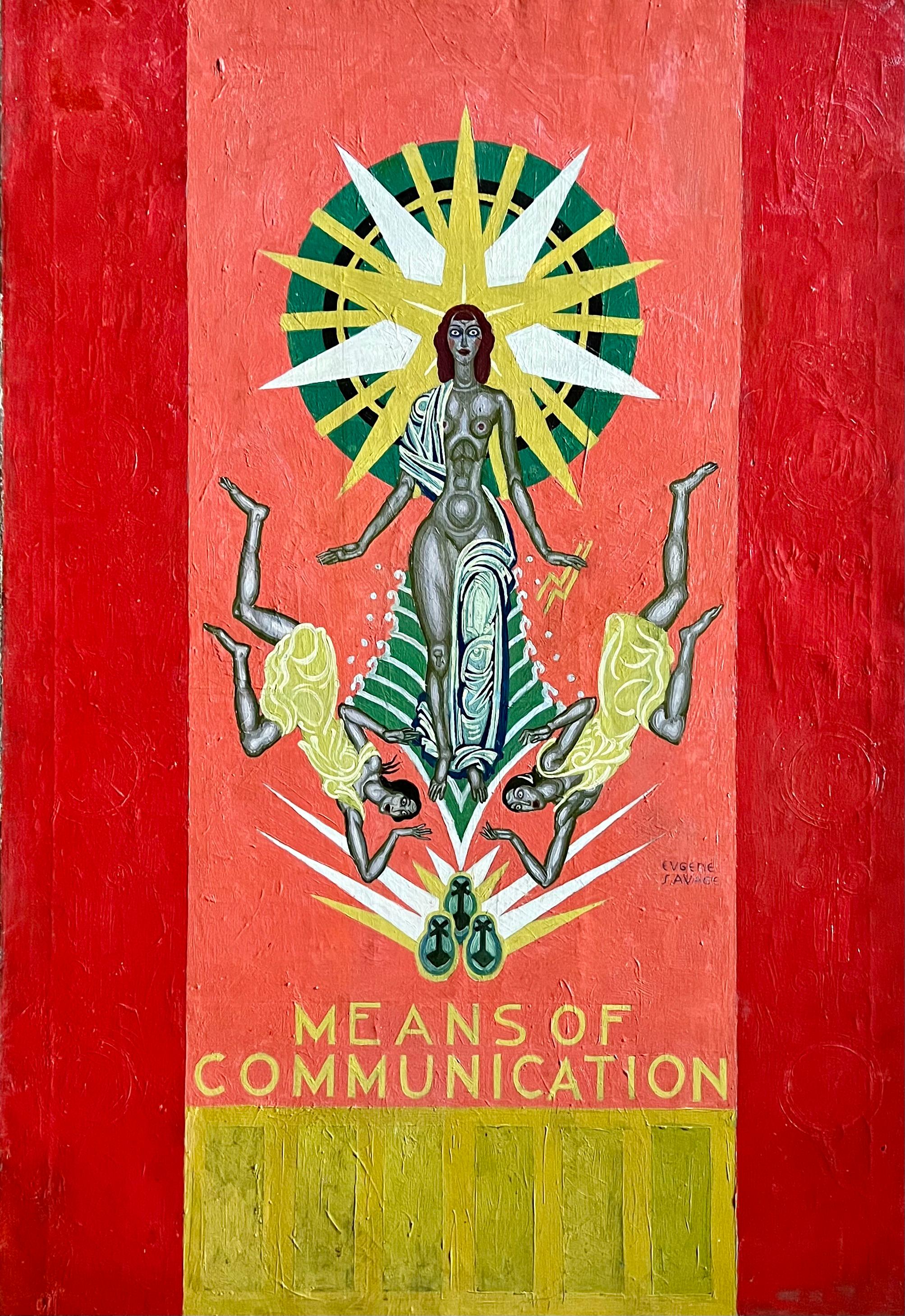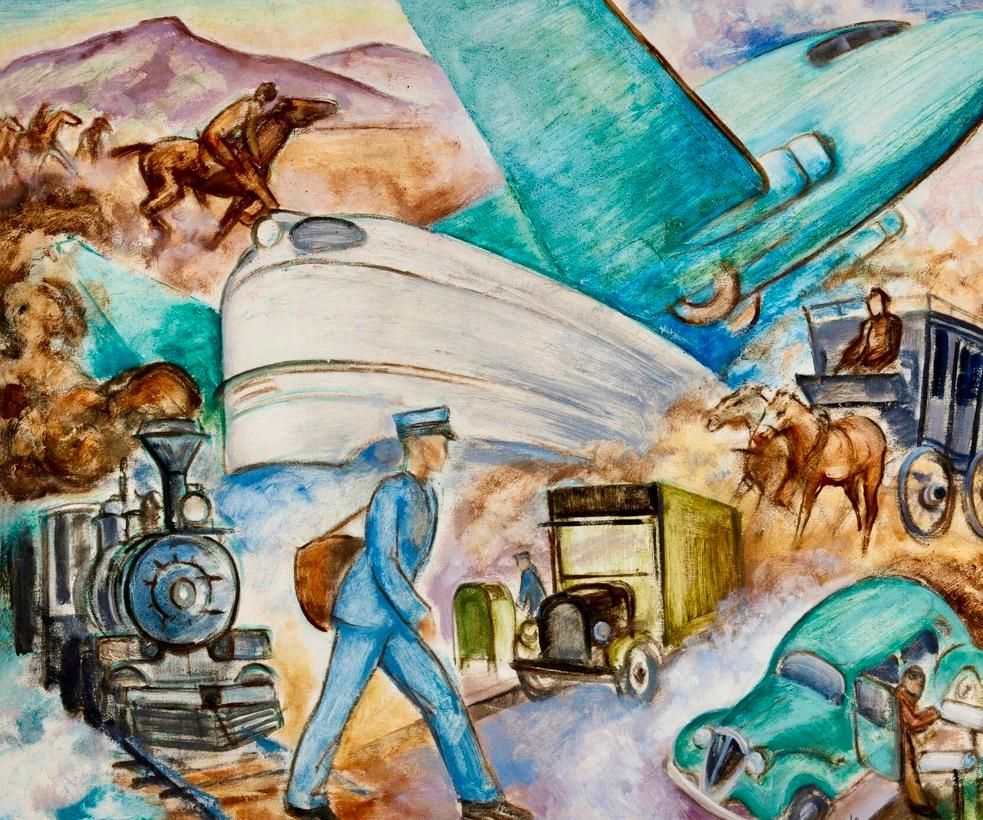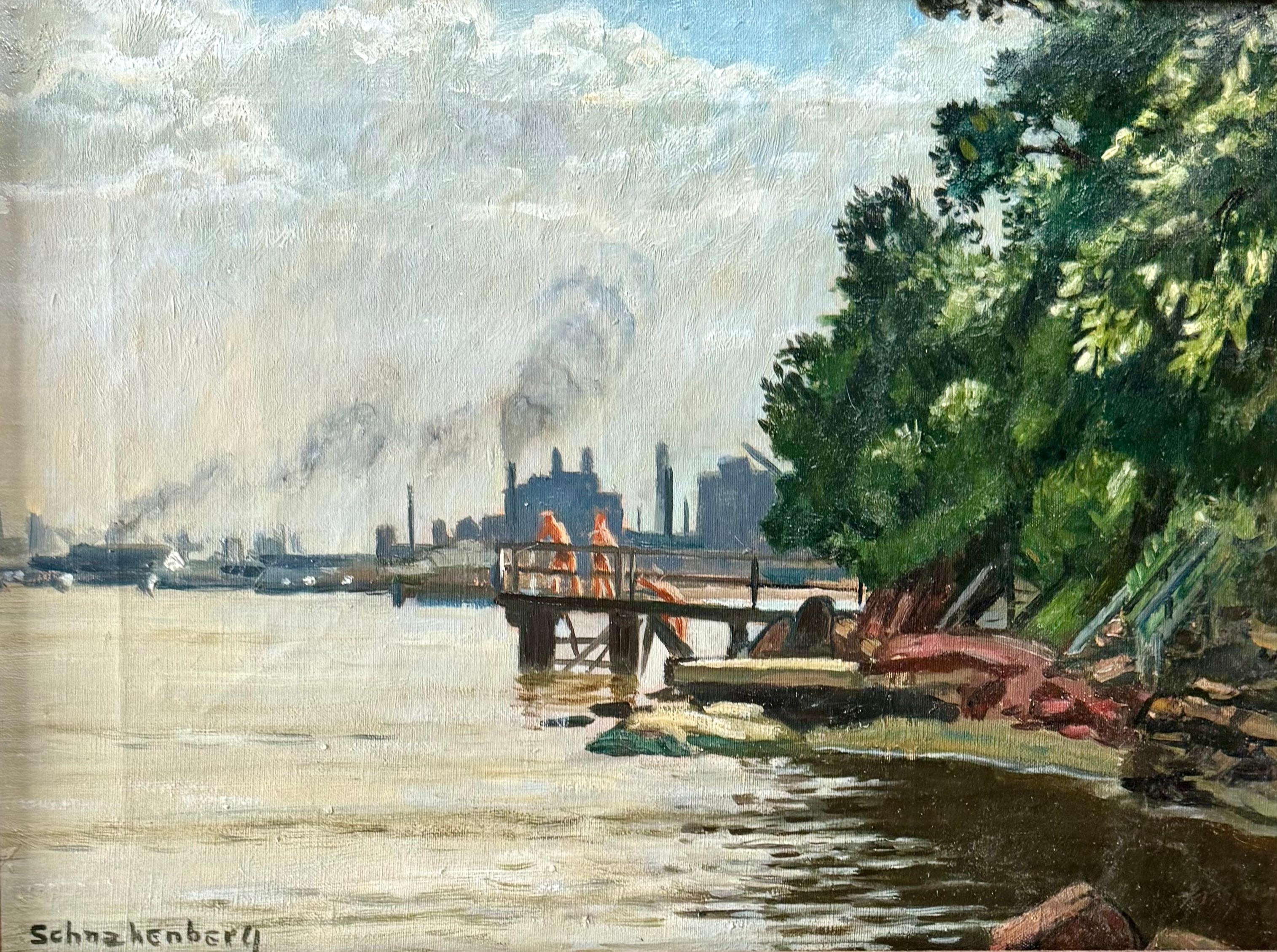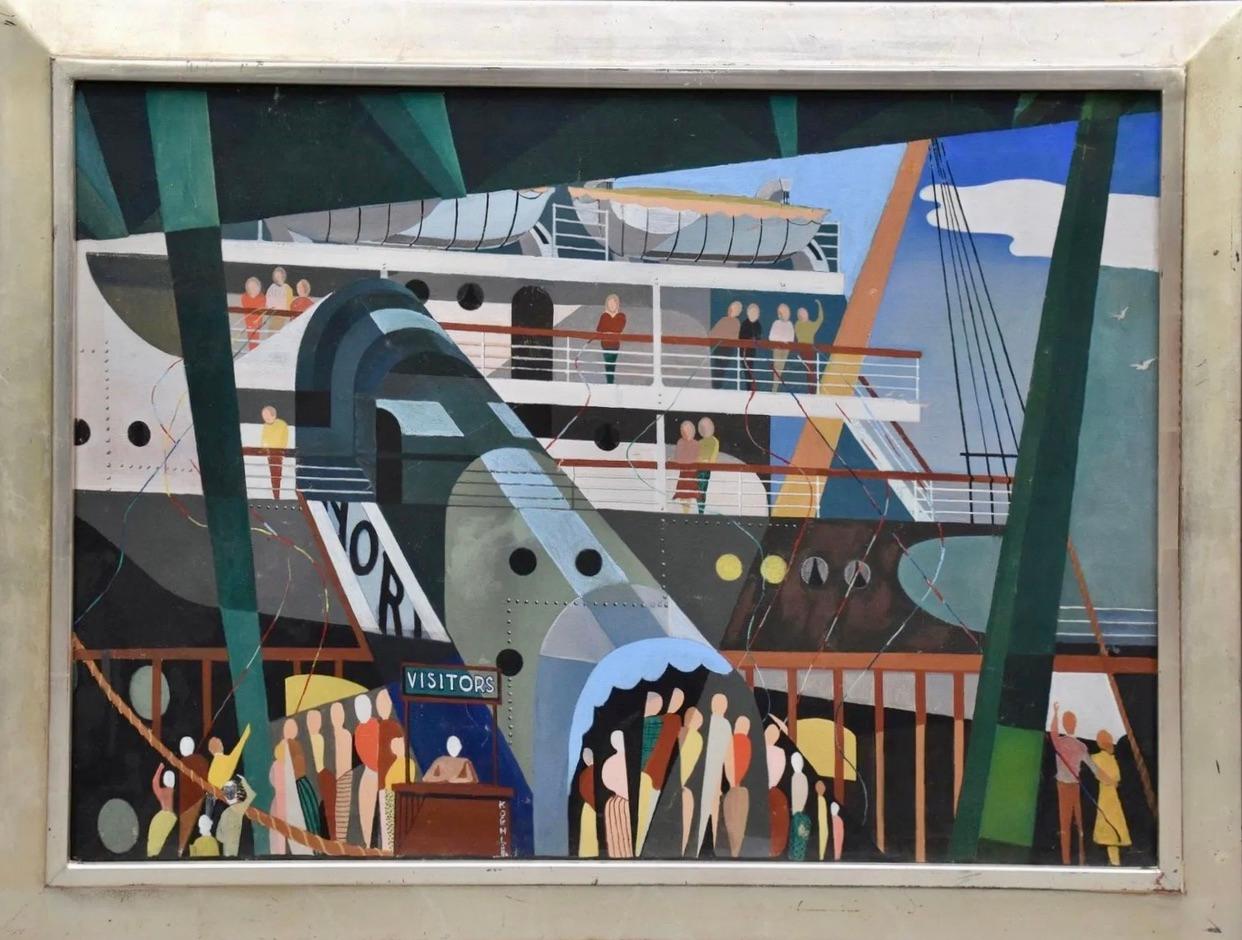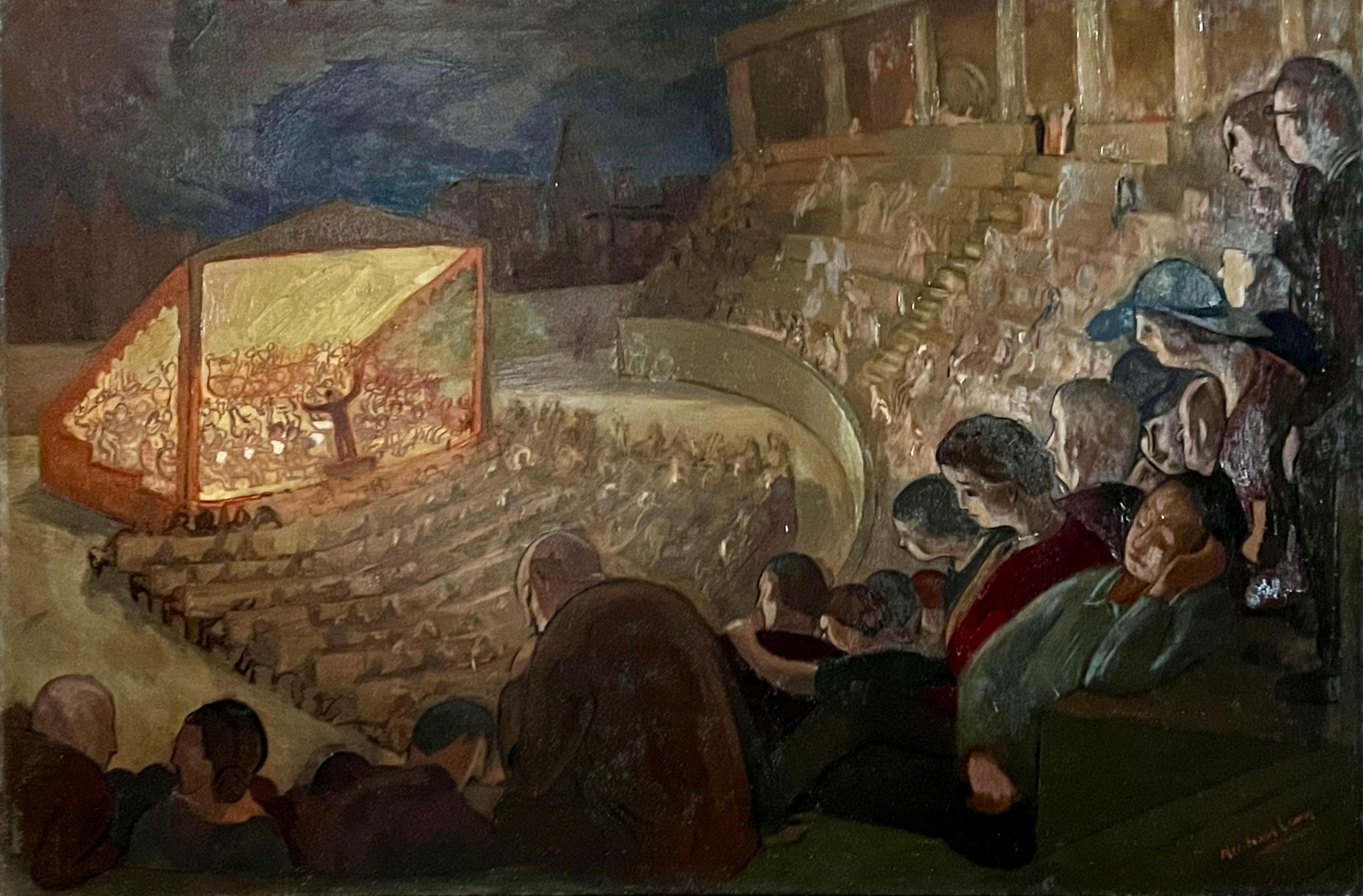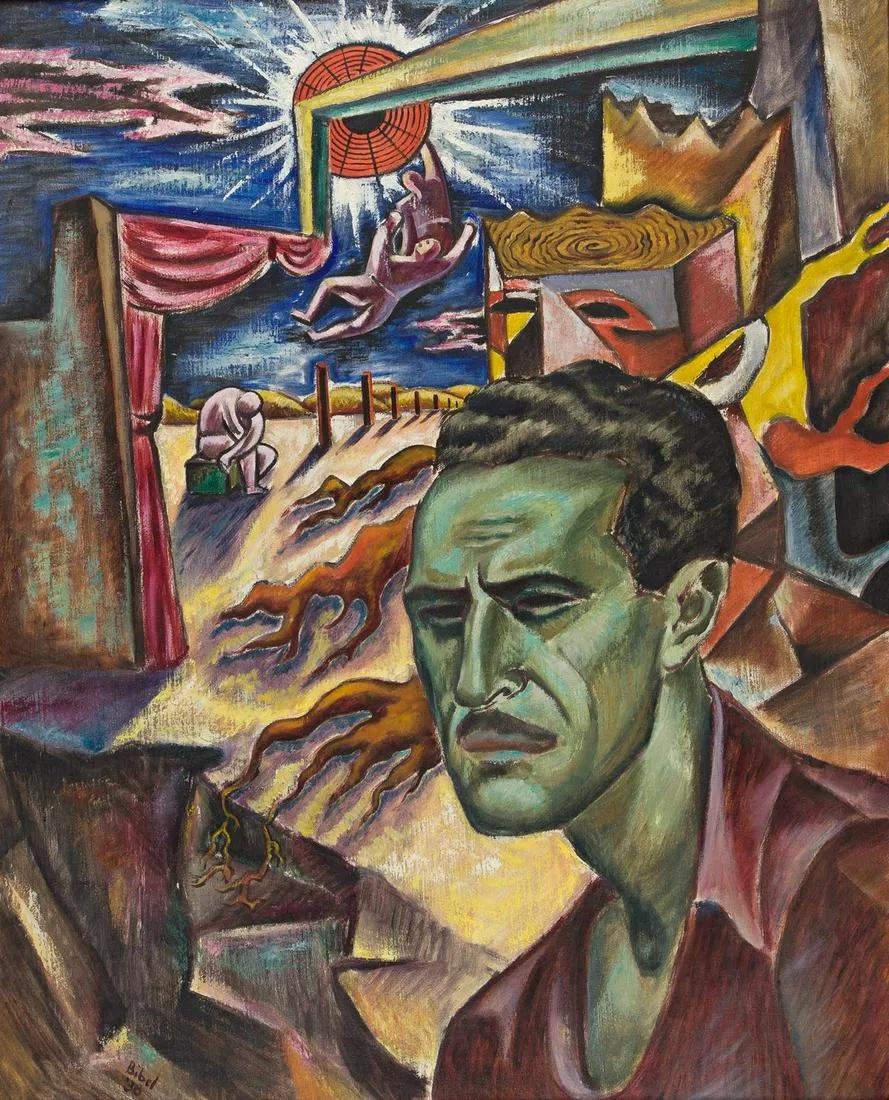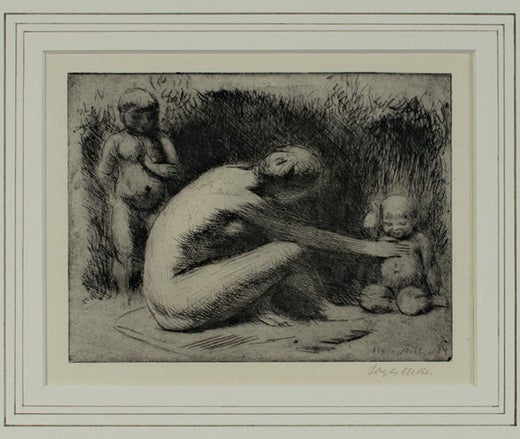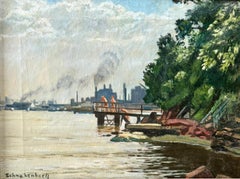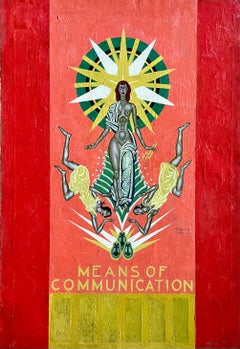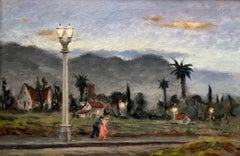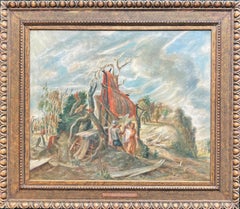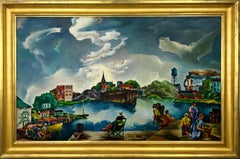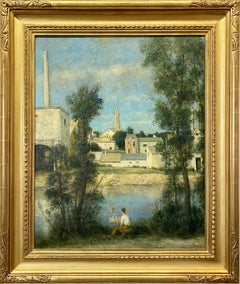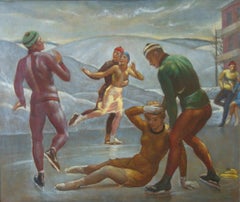
"The Skaters" WPA American Winter Scene Mid-Century Modernism Figure Skating
View Similar Items
Want more images or videos?
Request additional images or videos from the seller
1 of 10
Kenneth Hayes Miller"The Skaters" WPA American Winter Scene Mid-Century Modernism Figure Skating1942
1942
Price:$95,000
About the Item
- Creator:Kenneth Hayes Miller (1876-1952, American)
- Creation Year:1942
- Dimensions:Height: 33 in (83.82 cm)Width: 38 in (96.52 cm)
- Medium:
- Movement & Style:
- Period:
- Condition:
- Gallery Location:New York, NY
- Reference Number:1stDibs: LU115625027632
Kenneth Hayes Miller
Kenneth Hayes Miller is best known as a teacher and founder of what became known as the Fourteenth Street school. While paintings of middle-class female shoppers from his mature period are his best known, he had a long, distinctly different early phase. Miller was born in the utopian community of Oneida and studied art in the 1890s at the New York School of Art with William Merritt Chase and later at the Art Students League with several prominent, traditional, mural painters, such as Kenyon Cox and H. Siddons Mowbray. Works from his first sustained period of painting are mostly of nude figures set in idealized, romantic landscapes. These poetic, somewhat symbolic paintings, similar to the art of his contemporaries Arthur B. Davies and Bryson Burroughs, were largely inspired by Albert Pinkham Ryder, an artist Miller admired and befriended. After World War I Miller turned to realism. Like the Ash Can school painters, he became a delineator of the ordinary pedestrian, but unlike them was fascinated with the human figure as a vehicle for plastic interpretation. His painting style became less atmospheric as he brightened his palette and delineated objects more clearly. His depictions of robust female shoppers in groups, pairs, or alone established his reputation in the 1920s and 1930s. He also continued to paint the female nude but placed the figure in interior settings and rendered it as a more sensuous and real body than he had in his earlier idealized works. Throughout his career Miller was also interested in etching and sometimes repeated his painted images in prints. After a trip to Europe in 1900 Miller began a long teaching career, first at the Chase School of Art, and when that dissolved, in 1911 he began his more than forty-year association with the Art Students League. His numerous students there included Peggy Bacon, George Bellows, Isabel Bishop, Arnold Blanch, Patrick Henry Bruce, Minna Citron, John McCrady, Thelma Cudlipp, Horace Day, Dorothy Eaton, Arnold Friedman, Lloyd Goodrich, Josephine Hopper, Rockwell Kent, Yasuo Kuniyoshi, Emma Fordyce MacRae, Edward Middleton Manigault, Reginald Marsh, George L.K. Morris, Walter Tandy Murch, Louise Emerson Ronnebeck, George Tooker, Russel Wright, Albert Pels, William C. Palmer, Molly Luce, and Helen Winslow Durkee. In his teaching Miller stressed the importance of learning from the art of the past, in particular that of the Renaissance. He was also instrumental in reviving old-master techniques such as casein and tempera painting.
About the Seller
5.0
Gold Seller
Premium sellers maintaining a 4.3+ rating and 24-hour response times
Established in 2008
1stDibs seller since 2019
191 sales on 1stDibs
Authenticity Guarantee
In the unlikely event there’s an issue with an item’s authenticity, contact us within 1 year for a full refund. DetailsMoney-Back Guarantee
If your item is not as described, is damaged in transit, or does not arrive, contact us within 7 days for a full refund. Details24-Hour Cancellation
You have a 24-hour grace period in which to reconsider your purchase, with no questions asked.Vetted Professional Sellers
Our world-class sellers must adhere to strict standards for service and quality, maintaining the integrity of our listings.Price-Match Guarantee
If you find that a seller listed the same item for a lower price elsewhere, we’ll match it.Trusted Global Delivery
Our best-in-class carrier network provides specialized shipping options worldwide, including custom delivery.More From This Seller
View All"War Brides, Wash Sq NYC" American Scene WWII Modernism WPA Mid-Century Oil
By Georgina Klitgaard
Located in New York, NY
"War Brides, Wash Sq NYC" American Scene WWII Modernism WPA Mid-Century Oil. 30 x 40 inches. Oil on canvas, c. 1942. Signed lower right. Titled on the stretcher. Housed in a sensational Heydenryk frame.
Our gallery, Helicline Fine Art...
Category
1940s American Modern Landscape Paintings
Materials
Canvas, Oil
Boys Swimming Industrial Landscape WPA Mid 20th Century Social Realism Modernism
By Henry Ernst Schnakenberg
Located in New York, NY
Boys Swimming Industrial Landscape WPA Mid 20th Century Social Realism Modernism
Henry Schnakenberg (1982 - 1970)
Boys Swimming Industrial Landscape
11 1/2 x 15 1/2 sight
Oil on Canvas
Signed lower left
14 1/2 x 18 1/2 inches, Framed
Bio
In many cases, American artists visited the Armory Show in New York in 1913, and returned to their studios to react to or against what they saw. However, for Henry Ernest Schnakenberg it was much more life altering. Prior to visiting this important exhibition of American and European modernist art...
Category
1940s American Modern Figurative Paintings
Materials
Canvas, Oil
Coney Island Fire Eaters American Scene Modernism WPA Social Realism Mid-Century
Located in New York, NY
Coney Island Fire Eaters American Scene Modernism WPA Social Realism Mid-Century
Frederick "Fritz" Frey Rockwell (1917-1977)
Coney Island Fire Eaters
25 x 30 inches
Oil on Canvas
Si...
Category
1930s American Modern Figurative Paintings
Materials
Canvas, Oil
NYC 1939 World's Fair Mural Study American Scene WPA Modern Mid 20th Century
Located in New York, NY
NYC 1939 World's Fair Mural Study American Scene WPA Modern Mid 20th Century
Eugene Savage (1883 – 1978)
1939 World’s Fair Mural Study
45 x 30 inches
Oil on Canvas
Signed lower right
The painting is part of a 1,000 piece collection of art and objects from the 1939 World’s Fair. The collection as a whole is available.
Savage created the mural for the facade of the Communications Building. An image of the completed mural, along with a published postcard, is part of the listing. Note the center top female figure, she resembles the figure in the offered painting.
BIO
Eugene Francis Savage was born in Covington, Indiana 1883. He underwent various forms of art training in the early years. He was a pupil of The Corcoran Gallery and The Art Institute of Chicago, and was later awarded a fellowship to study in Rome at The American Academy.
While under the spell of that ancient city the young artist began to render historic figures that were suitable for the classic style needed for mural painting in the traditional manor. During this period he was able to study and observe Roman and Greek sculpture, although much of the academic training was accomplished by using plaster casts along with the incorporation of live models. This method survived and was used efficiently throughout Europe and the United States.
After leaving the Academy, Savage was commissioned to paint numerous murals throughout the United States and Europe. This artist received acclaim for the works he produced while under commissions from various sources. This young master was a contemporary of Mexican muralists David Alfaro Siqueiros (1896-1974), Jose Clemente Orozco (1883-1949) and Diego Rivera (1886-1957). In this period he was to show the influence of his contemporaries in formulating a modern style. Savage also played a vital role in the WPA Federal Art program, and he was a member of The Mural Art Guild..
Savage was elected an associate member of The National Academy of Design in 1924 and a full member in 1926. From 1947, he held a professorship at Yale University where he taught mural painting, and some of his students went on to significant positions.
By this time the artist had painted large-scale murals at Columbia, Yale University, Buffalo N.Y., Dallas, Texas, Chicago, Indiana, along with other commissioned works. He also achieved recognition for a series of murals commissioned by the Matson Shipping Line and completed around 1940. For this commission, Savage made many exacting studies of customs and folkways of the Hawaiian natives. However, the award-winning murals were not installed as planned but were put in storage during the war years when the ships were used for troop transportation and were in danger of attack.
However the mural images were reproduced and distributed by the shipping company including nine of the mural scenes that were made into lithographed menu covers in 1948. The American Institute of Graphic Arts awarded certificates of excellence for their graphic production, and the Smithsonian Institute exhibited the works in 1949. Today Savages' Hawaiian Art production is held in high regard by collectors of Hawaiian nostalgia.
In later years the artist focused his attention on a theme that dealt with the customs and tribal traditions of the Seminole Indians of Florida. He produced many variations of this theme throughout his lifetime, and the pictures were usually modest scale easel paintings, precise and carefully delineated. Many of these pictures incorporate Surrealistic elements and show some minor stylistic influences of the painters Kay Sage...
Category
1930s American Modern Figurative Paintings
Materials
Canvas, Oil
"History of US Postal Service" American Scene Social Realism WPA Modern Chicago
By Harold Haydon
Located in New York, NY
"History of US Postal Service" American Scene Social Realism WPA Modern Chicago
Harold Haydon
"History of the U.S. Postal Service"
21 x 25 1/2 inches
O...
Category
1930s American Modern Figurative Paintings
Materials
Canvas, Oil
"Cruise Ship Rolls In" Mid 20th Century American Contemporary Modern Realism
Located in New York, NY
"Cruise Ship Rolls In" Mid 20th Century American Contemporary Modern Realism
This is one sensational painting. And we can even identify the artist, but can't find anything about the...
Category
Mid-20th Century American Modern Figurative Paintings
Materials
Canvas, Oil
You May Also Like
Six O'Clock
Located in Los Angeles, CA
Six O-Clock, c. 1942, oil on canvas, 30 x 20 inches, signed and titled several times verso of frame and stretcher (perhaps by another hand), marked “Rehn” several times on frame (for the Frank K. M. Rehn Galleries in New York City, who represented Craig at the time); Exhibited: 1) 18th Biennial Exhibition of Contemporary American Oil Paintings from March 21 to May 2, 1943 at The Corcoran Gallery of Art in Washington, D.C. #87, original price $450 (per catalog) (exhibition label verso), 2) Craig’s one-man show at the Frank K. M. Rehn Galleries, New York City, from October 26 to November 14, 1942, #10 (original price listed as $350); and 3) Exhibition of thirty paintings sponsored by the Harrisburg Art Association at the State Museum of Pennsylvania in Harrisburg in March, 1944 (concerning this exhibit, Penelope Redd of The Evening News (Harrisburg, Pennsylvania) wrote: “Other paintings that have overtones of superrealism inherent in the subjects include Tom Craig’s California nocturne, ‘Six O’Clock,’ two figures moving through the twilight . . . .” March 6, 1944, p. 13); another label verso from The Museum of Art of Toledo (Ohio): original frame: Provenance includes George Stern Gallery, Los Angeles, CA
About the Painting
Long before Chris Burden’s iconic installation outside of the Los Angeles County Museum of Art, Urban Light, another artist, Tom Craig, made Southern California streetlights the subject of one of his early 1940s paintings. Consisting of dozens of recycled streetlights from the 1920s and 1930s forming a classical colonnade at the museum’s entrance, Burden’s Urban Light has become a symbol of Los Angeles. For Burden, the streetlights represent what constitutes an advanced society, something “safe after dark and beautiful to behold.” It seems that Craig is playing on the same theme in Six O-Clock. Although we see two hunched figures trudging along the sidewalk at the end of a long day, the real stars of this painting are the streetlights which brighten the twilight and silhouette another iconic symbol of Los Angeles, the palm trees in the distance. Mountains in the background and the distant view of a suburban neighborhood join the streetlights and palm trees as classic subject matter for a California Scene painting, but Craig gives us a twist by depicting the scene not as a sun-drenched natural expanse. Rather, Craig uses thin layers of oil paint, mimicking the watercolor technique for which he is most famous, to show us the twinkling beauty of manmade light and the safety it affords. Although Southern California is a land of natural wonders, the interventions of humanity are already everywhere in Los Angeles and as one critic noted, the resulting painting has an air of “superrealism.”
About the Artist
Thomas Theodore Craig was a well-known fixture in the Southern California art scene. He was born in Upland California. Craig graduated with a degree in botany from Pomona College and studied painting at Pamona and the Chouinard Art School with Stanton MacDonald-Wright and Barse Miller among others. He became close friends with fellow artist Milford Zornes...
Category
1940s American Modern Landscape Paintings
Materials
Canvas, Oil
$12,500
Fish Story oil painting by Williams Charles Palmer
Located in Hudson, NY
This painting is illustrated in the Catalogue of the 1945 Encyclopedia Britannica Collection of Contemporary American Painting, p.84. Written and edited by Grace Pagano.
"Painting ...
Category
Mid-20th Century American Modern Figurative Paintings
Materials
Canvas, Oil
Summer Resort in Michigan -Modernist Mid-Century Saugatuck Oil Painting
Located in Marco Island, FL
Summer Resort in Michigan is an exceptional work painted by the Chicago Modernist, William Schwartz. He studied at the Art Institute of Chicago shortly ...
Category
1940s American Modern Landscape Paintings
Materials
Canvas, Oil
American Pastoral
By John Koch
Located in Greenwich, CT
John Koch is a beloved American realist painter who depicted people in their everyday lives. Here we see a slightly different approach where he has put a painter out in a rural town...
Category
1940s American Modern Landscape Paintings
Materials
Canvas, Oil
Halleluja, A story
Located in Greenwich, CT
Initially read as archaic and simple, Halleluja is a complex celebratory spring painting full of color, imagination, and humor and combines many elements seen throughout her later ca...
Category
1940s American Modern Figurative Paintings
Materials
Canvas, Oil
The Market #2 - by Marc Zimmerman
By Marc Zimmerman
Located in Carmel, CA
The universal farmers market is bustling with action. Geometric stalls with intense color coupled with contrasting blue arches creates the dynamism in this work of art.
The Market #...
Category
2010s American Modern Figurative Paintings
Materials
Canvas, Oil
Recently Viewed
View AllRead More
Ludwig Bemelmans Captures the Thrilling Sight of Coney Island at Night
The ‘Madeline’ creator and Carlyle Hotel legend was in a New York state of mind in the 1940s when he produced this exuberant and rare oil painting.
Mid-Century Americans Didn’t Know Antonio Petruccelli’s Name, but They Sure Knew His Art
The New York artist created covers for the nation’s most illustrious magazines. Now, the originals are on display as fine art.
More Ways To Browse
Vintage Figure Skater
Charles Mcgee
F Wagner Painting
Faure Le
John Everett Millais
Josip Generalic
K Beck
Milkmaid Painting
Peter Max Better World Acrylic Painting
Saturday Evening Post 1921
Sironi Mario
Susan Noble
Tyree Guyton
W James Venice
17th Century Memento Mori Paintings
Amigo Oil Painting
Anne Poor
Bruce Penney
